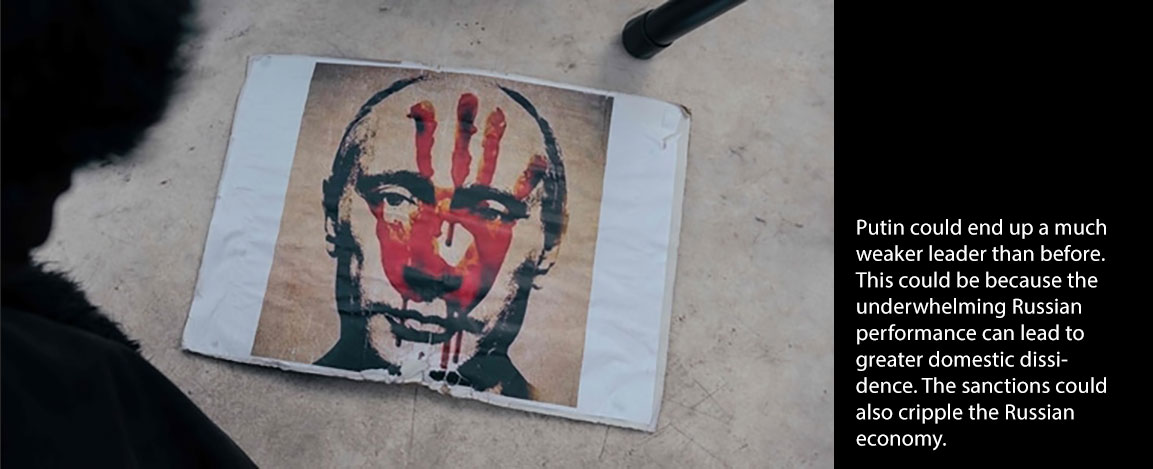The war can end in three possible scenarios for Vladimir Putin. In every scenario, India and US interests are aligned, argues Kunal Singh, PhD student in the MIT Security Studies Program. This article was first published here in the Hindustan Times.
The Russian invasion of Ukraine has posed a challenge to India-United States (US) relations. We know the divergent positions of India and the US. The puzzling part is that if both have a common interest in balancing China, this divergence should not exist. And yet it does. The current war can end in three possible scenarios for Russian president Vladimir Putin. In each scenario, we will see that India and US interests are quite aligned.
In scenario 1, Putin ends up a much weaker leader than before. This could be because the underwhelming Russian performance can lead to greater domestic dissidence. The sanctions could also cripple the Russian economy, eroding Putin's ability to distribute resources among his selectorate. However, given his grip over the State apparatus, pre-installed coup-proofing procedures, and control over the flow of information, Putin would still continue in office. This scenario is bad for India because Putin would be overly dependent on China to keep the Russian economy afloat. Beijing might even earn a veto over Russian transfers of defence equipment to India. This scenario is not great for the US as well. While Russia would indeed get weakened, the ultimate winner would be China - America's number one adversary. There are a number of defence technologies in which Russia holds an upper hand over China, for instance, nuclear submarines. Vital technologies might fall into Chinese hands too easily in this scenario. Chinese companies may also get to control a share of Russia's hydrocarbon production.
In scenario 2, Putin ends up stronger. This looks extremely unlikely at the moment but we must consider it for theoretical completeness. The war may suddenly turn in Russia's favour. The sanctions may not damage Russia's economy much. The US and Europe might realise that Russia as a source of energy is not easily replaceable. The fillip in energy prices might more than offset the loss due to various other sanctions. This is a good outcome for India. Russia's global standing would be enhanced and it would not be dependent on China. Russia could actually cooperate with India in balancing China. The decrease in Chinese leverage over Russia will also be good for the US. China would not acquire coveted defence technologies easily. In the past, we have seen Russia crack down on Chinese attempts to steal defence technologies and we might see that even more. Better India-Russia cooperation will complicate China's strategic environment and perhaps dissuade it from taking reckless actions in the Taiwan Strait or in the South China Sea - known areas of interest for the US.
In scenario 3, Putin ends up getting replaced by another leader. If the new leader is someone like Putin, we will end up with scenario 1. But it is unlikely that Putin will be replaced by someone like himself. The circumstances under which he will be replaced - coup, public protests or externally-aided regime change - make sure that the replacement is likely to pursue a different path, which should manifest in a more pro-western foreign policy. The unfolding of this scenario carries the risk of nuclear weapons-use by Putin. If nuclear weapons do not come to be involved, this is the best-case scenario for both India and the US. A pro-West leader in Moscow would mean that India could get Russian arms without fear of sanctions and the US would have achieved two prizes: A victory over Putin and a new partner to balance China. This is the scenario Beijing would like to avoid at all cost.
If the interests of India and the US are so aligned in all scenarios, why do we see such divergence in policy positions and public rhetoric? This divergence could be stemming from one or more of the following three reasons: First, the US regards Russia as a near-peer competitor, not far from China. The underlying assumption in all three scenarios mentioned is that China is the ultimate challenge for the US and Russia is a distant second. Perhaps, the US doesn't see it that way and it regards rivalry with Russia a close second after China. If that is the case, scenario 1 is great for the US and very bad for India. Scenario 2 is exactly the opposite.
Second, the US might see its actions vis-a-vis Russia in this war as a demonstration of resolve to China. It might be aiming to show China that any attempted use of force across the Taiwan Strait would see a similar response in terms of harshest punishment possible. In this line of thinking, China remains the US's biggest rival and the purpose of America's involvement in Ukraine is to deter China's future adventures.
Third, the US might be interested not so much in who the primary rival is but in protecting a norm of territorial sovereignty. Of course, the US has a bad record here. It invaded Iraq, did not follow the international court verdict on Diego Garcia and allowed China to get away with salami slicing in the South China Sea. However, it might still be willing to draw a line when an aggressor aims to capture an entire country - like Russia in Ukraine or Iraq in Kuwait. If the US thinks this way, China can expect to get away with a lot if it doesn't try to get that whole lot in one big attempt.
Indian policymakers should sit with their American counterparts and try to ascertain which among the above motivations are in play. If it is the first, India and the US may have convergence only if Putin gets replaced - a low-probability event. If the other two motivations are at play, there is still an opportunity to narrow the divergence between India and the US on Ukraine.




